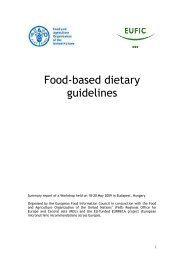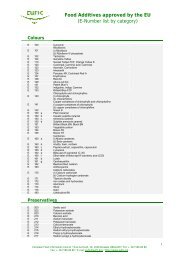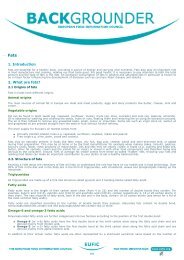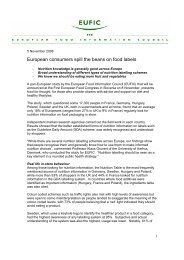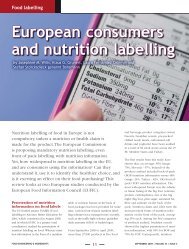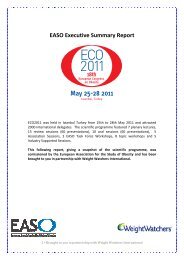Global Update on Nutrition Labelling - The European Food ...
Global Update on Nutrition Labelling - The European Food ...
Global Update on Nutrition Labelling - The European Food ...
Create successful ePaper yourself
Turn your PDF publications into a flip-book with our unique Google optimized e-Paper software.
EUFIC’s <str<strong>on</strong>g>Global</str<strong>on</strong>g> <str<strong>on</strong>g>Update</str<strong>on</strong>g> <strong>on</strong> Nutriti<strong>on</strong> <strong>Labelling</strong> - January 2012<br />
the FOP that graphically c<strong>on</strong>vey calorie counts by serving size and a “point” value showing<br />
whether the saturated and trans fat, sodium and added sugars in the products are below<br />
threshold levels (Institute of Medicine, 2011). This system has not yet been c<strong>on</strong>sumer tested.<br />
In the meantime, the Grocery Manufacturers of American (GMA) and the <strong>Food</strong> Marketing<br />
Institute (FMI), representing leading U.S. food and beverage manufacturers and retailers<br />
respectively, launched a new voluntary fact-based FOP nutriti<strong>on</strong> labelling system called<br />
Nutriti<strong>on</strong> Keys. This system adds nutriti<strong>on</strong> informati<strong>on</strong> <strong>on</strong> calories and other important<br />
nutrients (saturated fat, sodium and total sugars c<strong>on</strong>tent) to the FOP of many of the country’s<br />
food and beverage products. Operators may choose to display up to two out of eight of the<br />
“nutrients to encourage” (e.g. fibre, calcium) <strong>on</strong> the FOP in additi<strong>on</strong>. <strong>The</strong> Nutriti<strong>on</strong> Keys<br />
labelling c<strong>on</strong>cept was c<strong>on</strong>sumer tested to determine comprehensi<strong>on</strong>, ease of understanding<br />
and interpretati<strong>on</strong>. <strong>The</strong> labels will be rolled out in the coming<br />
m<strong>on</strong>ths according to seas<strong>on</strong>ality and producti<strong>on</strong> schedules and<br />
promoted with a $50 milli<strong>on</strong> c<strong>on</strong>sumer educati<strong>on</strong> campaign in<br />
autumn 2011.<br />
<strong>The</strong> directi<strong>on</strong> the<br />
U.S. and EU take will<br />
certainly have global<br />
implicati<strong>on</strong>s.<br />
Another key recent development for FOP labels is the EU’s<br />
adopti<strong>on</strong> of the Regulati<strong>on</strong> <strong>on</strong> <strong>Food</strong> Informati<strong>on</strong> to C<strong>on</strong>sumers.<br />
<strong>The</strong> regulati<strong>on</strong> allows for voluntary FOP labelling, but if operators choose to display FOP<br />
nutriti<strong>on</strong> informati<strong>on</strong>, it must follow the regulati<strong>on</strong>. <strong>The</strong> informati<strong>on</strong> for energy, fat, saturates,<br />
sugars and salt may be repeated <strong>on</strong> the FOP per 100g/ml or per porti<strong>on</strong>. Additi<strong>on</strong>al forms of<br />
expressi<strong>on</strong> and presentati<strong>on</strong> of the nutriti<strong>on</strong> declarati<strong>on</strong>, such as colours, graphical forms or<br />
symbols, are permitted under certain c<strong>on</strong>diti<strong>on</strong>s established in the regulati<strong>on</strong>.<br />
In Australia and New Zealand, the nutriti<strong>on</strong> labelling debate has reached a critical stage as<br />
the <strong>Food</strong> <strong>Labelling</strong> Law and Policy review for the Ministerial Council of <strong>Food</strong> Standards<br />
Australia New Zealand (FSANZ) was released in January 2011. <strong>The</strong> review recommends that a<br />
voluntary multiple traffic lights FOP labelling system should be introduced and should be<br />
mandatory if health claims are made or equivalent endorsements, trade names or marks<br />
appear <strong>on</strong> the label (Blewett et al., 2011). <strong>The</strong> Ministerial Council did not immediately<br />
endorse the report’s recommendati<strong>on</strong> for a traffic light system at its meeting in December<br />
2011 and has opted for further c<strong>on</strong>sultati<strong>on</strong> instead. Officials shall provide a substantial<br />
report <strong>on</strong> the development of a FoP labelling scheme within six m<strong>on</strong>ths, with a view to<br />
agreeing <strong>on</strong> a system by end 2012.<br />
In Asia, South Korea was the first country to press ahead with recommendati<strong>on</strong>s for<br />
voluntary traffic light labels <strong>on</strong> children’s food starting 1 January 2011. <strong>The</strong> Korean <strong>Food</strong> and<br />
Drug Administrati<strong>on</strong> revealed a draft plan for its system in May 2010, which would attach a<br />
red, yellow or green label to the package of food items depending <strong>on</strong> the amounts of fat,<br />
saturated fat, sugars and sodium. This move could potentially have implicati<strong>on</strong>s for other<br />
countries in the Asia-Pacific regi<strong>on</strong>.<br />
<strong>The</strong> Way Forward<br />
<strong>The</strong> debate over which nutriti<strong>on</strong> labelling scheme is the most effective will certainly c<strong>on</strong>tinue<br />
in Europe, Asia-Pacific and the United States for the foreseeable future. More research<br />
would certainly be useful to inform these discussi<strong>on</strong>s. Governments, NGOs, food<br />
manufacturers and retailers have all explored which scheme c<strong>on</strong>sumers might prefer, for<br />
what reas<strong>on</strong>s and how certain schemes impact purchasing behaviour and balanced choices.<br />
While some evidence has emerged <strong>on</strong> several of these issues, there remains no c<strong>on</strong>sensus<br />
am<strong>on</strong>g stakeholders <strong>on</strong> the way forward. Evidence <strong>on</strong> the impact of the various schemes <strong>on</strong><br />
purchasing behaviour, and therefore <strong>on</strong> their relative effectiveness in helping c<strong>on</strong>sumers<br />
make balanced choices, also remains limited, partly because of the relative novelty of<br />
7




